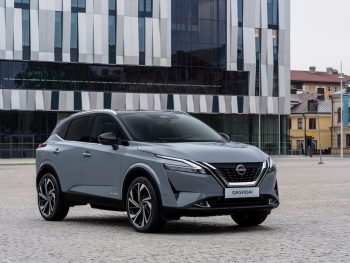Web Exclusive: Nissan Qashqai e-Power
John Challen samples the latest iteration of Nissan’s best-seller, complete with a clever electrified powertrain.

Nissan will only offer electrified vehicles in Europe from 2023
Nissan’s Qashqai is the car that kicked off the now-crowded C-SUV sector when it hit the market back in 2007. Since then, the model has amassed 5.5 million sales in more than 40 countries – with 2.2 million of those still on the road, according to the manufacturer.
Impressive, maybe, but Nissan says such success with reliability creates a problem when it comes to shifting more models. To help combat this issue, the Japanese company has deployed e-Power technology to the crossover, in a bid to offer an alternative to both EVs and many of the hybrids available on the market.
The e-Power model is part of an offensive that will see an electrified version of every Nissan model by 2023 and a goal of 75% of sales being electrified vehicles by 2026. Note the use of the term ‘electrified’, as opposed to electric.
The e-Power isn’t a pure EV, it uses a 1.5-litre three-cylinder turbocharged variable compression ratio petrol engine with 190hp, developed specifically for Qashqai. The engine has no physical link to the wheels, instead it generates electricity, which is transmitted via an inverter to the Qashqai’s 2.1kWh battery pack, the 190hp electric motor or both, depending on the situation. The new Qashqai CMF-C platform was developed specifically for e-Power, which enabled more interior space and improved driving dynamics.
In reality, the car operates with 100% EV drive, even though the actual EV range is no more than a couple of kilometres. The point? To offer drivers a glimpse into the electric future without going fully down the pure EV route. As Nissan puts it: “e-Power lets drivers get as close as possible to their next car, which will probably be an EV.” The company says that for people who are ready to fully commit there will be the option of the Ariya and, for others, there’s the Qashqai e-Power.
The use of the variable compression ratio engine helps the car achieve similar efficiency to a diesel version. That means 55.3mpg and 119g/km as well as a driving range of up to 1,000km (600+ miles). The latter number will be an attractive proposition for many fleet drivers who regularly cover large distances.
Four grades of the car will be available: Acenta Premium, N-Connecta, Tekna and Tekna+. The bulk of sales are likely to be N-Connecta, with spec highlights including dual 12.3-inch screens, front parking sensors and privacy glass. Moving up the range adds elements such as bigger wheels, heated seats and steering wheel and an upgraded Bose sound system.
Nissan’s key goals for the e-Power are a responsive drive, quietness, fuel efficiency and no need to plug it in. On all four, it hits the target. Particularly impressive is the NVH, which ensures a quiet cabin and calm environment. The approach might seem a bit of a halfway house for some, but it is one that is sure to hit the spot with some EV-resistant drivers.
IN BRIEF
WHAT IS IT? C-SUV
HOW MUCH? from £32,940
ECONOMY? 55.3mpg
EMISSIONS? 119g/km
Key fleet model: 2.0-litre Sport
Thumbs up: Refinement; clever powertrain tech
Thumbs down: PHEV might be more desirable to some drivers
Seven-word summary: An impressive stepping stone to pure EVs
Also consider: Honda HR-V; Kia Sportage HEV; Toyota RAV4













Victor Harman19. Jul, 2022
I don’t see any driving impressions on the Qashqai e-Power. Did JC actually drive one?